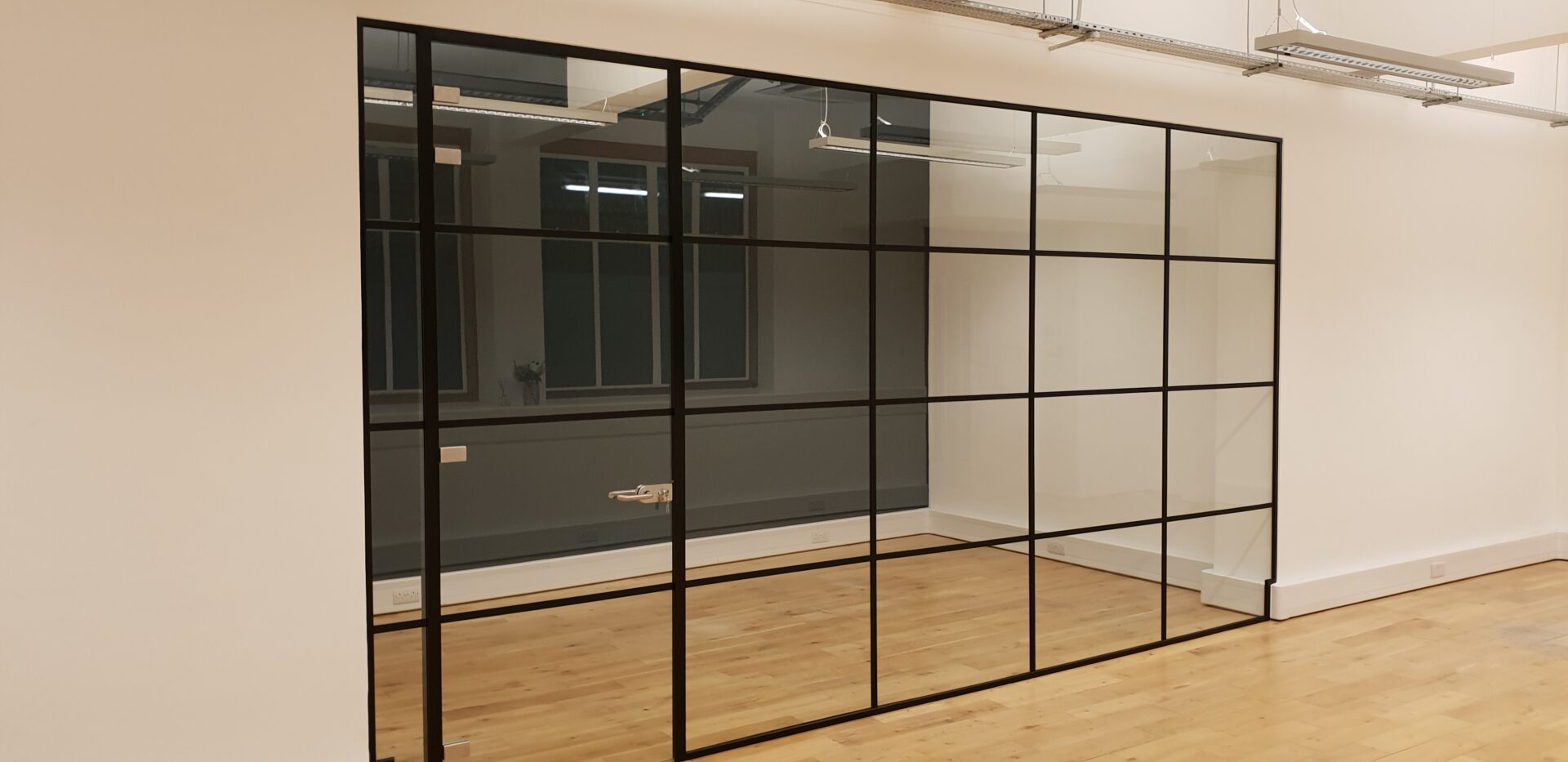
Black framed glass partitions are a go-to feature in modern office design, known for their bold aesthetic and ability to shape open work environments. But when it comes to small office spaces, many business owners and designers wonder: will they make the area feel smaller, or can they enhance the layout?
In this guide, we’ll explore why black framed partitions are so popular, how they function in compact work environments, and what design strategies can make them both practical and visually appealing. You’ll also discover the pros and cons, viable alternatives, and expert design tips to help you decide if they’re the right fit for your space.
Why are Black Framed Partitions So Popular in Offices?
Here are the main reasons why they continue to be such a popular choice in workplaces:
1. Industrial aesthetic: Their bold grid-like framework brings a modern industrial character to offices, a style strongly associated with creativity, innovation, and high-end urban interiors.
2. Balance of openness and structure: Unlike solid walls, they define zones while maintaining a visual connection across spaces. This helps small offices feel connected rather than boxed in.
3. Durability and flexibility: Made with powder-coated aluminium or steel, these frames can last for decades and often be reconfigured if your office layout changes.
Do They Actually Work in Small Office Spaces?
Yes, here are the main considerations:
1. Natural light benefits: Glass partitions allow natural light to penetrate deeper into the office, reducing the need for artificial lighting, a critical advantage in smaller layouts where windows may be limited.
2. Space definition without heavy construction: They create dedicated work zones (like meeting pods or private offices) without resorting to drywall, which would permanently block visibility and make the office feel even smaller.
3. Potential visual heaviness in tight layouts: The black grid can feel visually dominant in very compact spaces if used excessively. Without careful design, it risks making the space feel busy or compressed.
Design Tips for Making Black Framed Partitions Work in Small Offices
1. Choose slimmer profiles: Opt for partitions with slimmer mullions and frames to keep the look refined and reduce visual weight.
2. Position near natural light sources: Place partitions where they can capture and spread daylight, ensuring your office doesn’t feel enclosed.
3. Use partial or sliding systems: Instead of full-height partitions, consider half-height, clerestory, or sliding glass systems. These free up circulation space and add versatility to compact layouts.
4. Pair with neutral décor: Balance the boldness of black frames with lighter flooring, walls, and furniture. Neutral tones expand the sense of space, while the frame adds contrast and sophistication.
5. Integrate acoustic solutions: In small offices, noise travels quickly. Opt for acoustic glass or add soft furnishings like carpets, wall panels, and upholstered seating to offset sound reflection.
6. Customise grid patterns: Instead of default grids, try vertical-only or asymmetrical layouts to soften the look while maintaining the industrial vibe.
Get: Black Framed Glass Partitions
Pros and Cons of Black Framed Partitions in Small Offices
| Pros | Cons |
| Allow light flow through compact layouts | Can create visual clutter if overused |
| Stylish, modern, and timeless aesthetic | Strong black lines may feel heavy in tight areas |
| Define zones without permanent construction | Can visually compress space compared to frameless options |
| Highly durable and long-lasting | Acoustic control may require upgrades like double glazing |
Alternatives to Black Framed Partitions for Small Offices
If black frames feel too dominant for your space, here are lighter alternatives:
1. Frameless Glass Partitions
Frameless glass partitions are almost invisible, maximising openness while still dividing spaces. They’re perfect for small offices where maintaining the largest sense of space is key.
2. Aluminium Framed Partitions
Aluminium framed partitions are lightweight and available in softer finishes like white, grey, and bronze, making them feel less intense in smaller layouts..
3. Timber Framed Partitions
Timber framed partitions combine transparency with the warmth and texture of wood. They’re ideal for boutique offices, wellness spaces, or creative studios looking for a softer aesthetic.
4. Sliding Glass Partitions
Sliding glass partitions save circulation space and allow flexibility between open and closed setups, making them particularly useful in offices where every square metre counts.
Related Read: Frameless vs. Framed Office Glass Partitions
Final Thoughts
Black framed glass partitions can absolutely work in small office spaces, but only when designed with care. The key is balance: leveraging the natural light, creating structure without overwhelming, and complementing the frames with thoughtful finishes and furnishings.
If you’re considering an upgrade, weigh both the benefits and limitations, and don’t overlook alternatives that might suit your team’s needs better.
FAQs
Not if paired with the right décor. Light walls, floors, and furnishings help balance the bold frames.
.
Yes, many suppliers offer sliding and folding systems that are perfect for compact spaces.
Unlike solid walls, they keep sightlines open, preventing the office from feeling boxed in.
Absolutely. Many offices mix black frames with frameless or solid walls to achieve both openness and privacy.
Yes, black framed partitions can be designed to fit sloped ceilings, alcoves, or angled spaces.
Standard single-glass systems don’t provide strong soundproofing, but acoustic glass or double glazing can resolve this.












